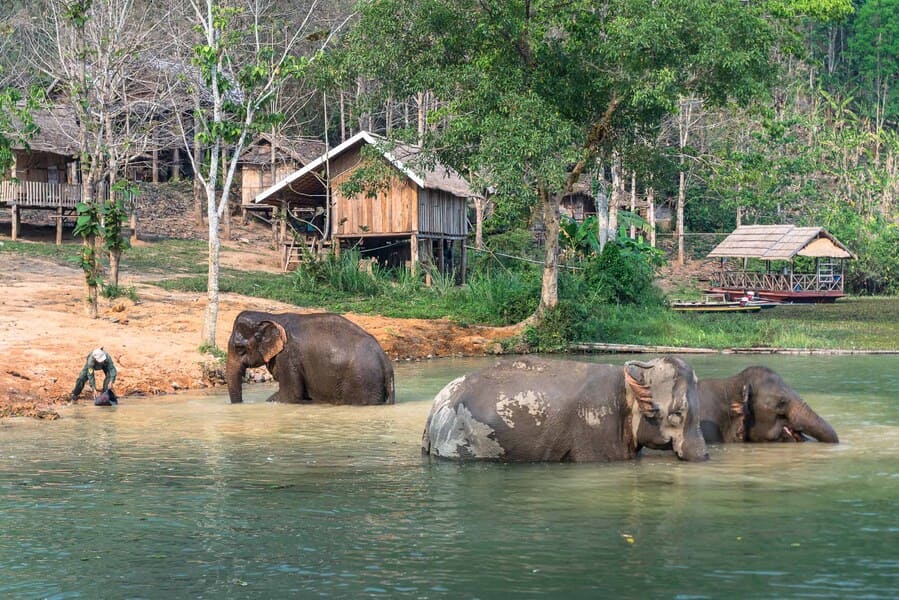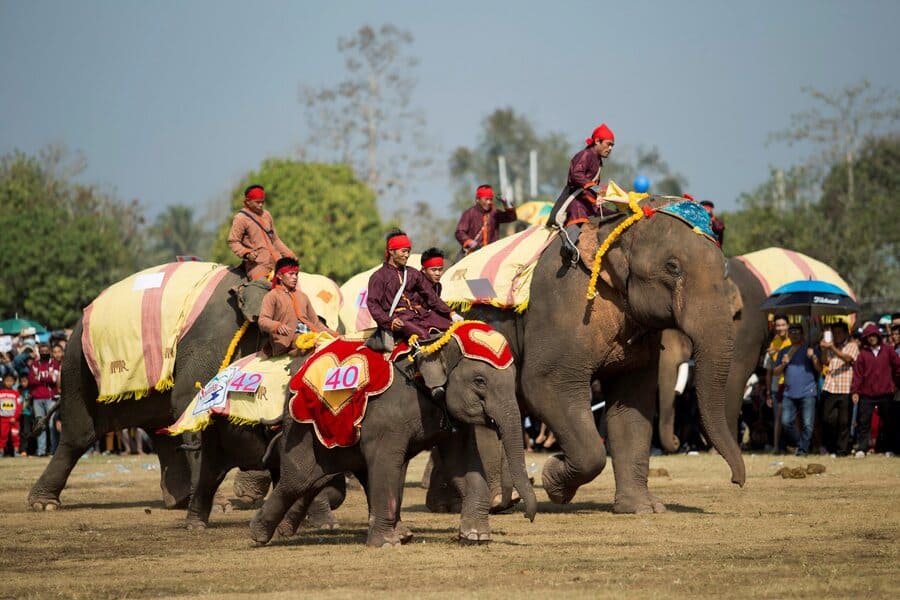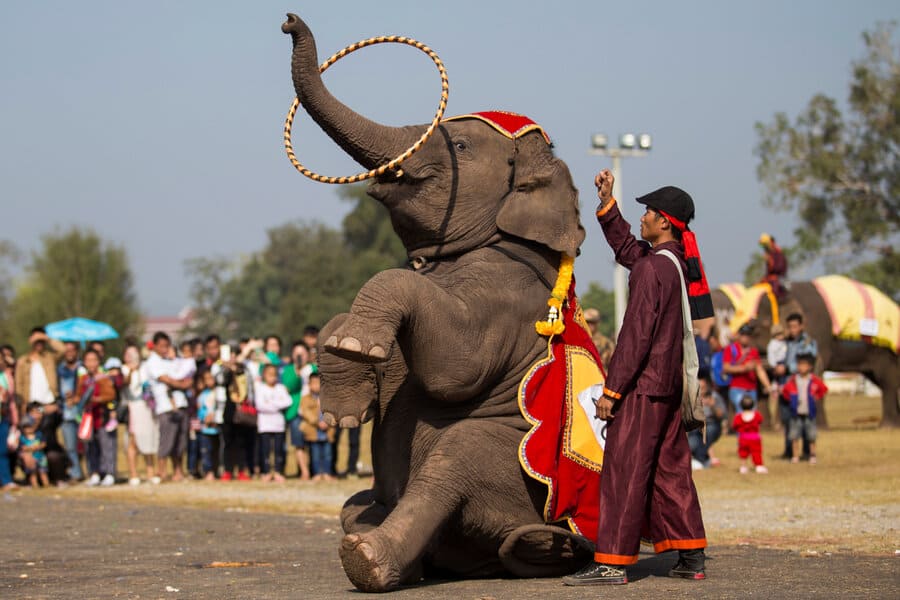Nestled amidst the verdant embrace of northern Laos lies Xayaboury, a province teeming with natural wonders and rich cultural heritage. But Xayaboury isn't just a picturesque destination; it's a haven for pachyderm enthusiasts. Here, amidst rolling hills and lush jungles, you'll find a place dedicated to the gentle giants – the elephants. Prepare to be captivated by Xayaboury, home to the country's largest elephant conservation center and the annual elephant festival, a vibrant celebration of these magnificent creatures during your laos tours.
Where is Xayaboury?
Xayaboury, also spelled Sainyabuli or Xaignabouli, is a province tucked away in northern Laos. Imagine a place cradled by the mountainous Luang Prabang Range to the east and sharing a border with Thailand to the west. The Mekong River, a vital artery of Southeast Asia, snakes its way through the province, nourishing the lush landscapes that Xayaboury is famous for.
What to Expect in Xayaboury?
Famed for its Elephant Conservation Center, a haven dedicated to protecting these magnificent creatures, Xayaboury also comes alive every February with a vibrant Elephant Festival. This annual celebration is a spectacle of parades, games, and cultural events, all centered around honoring the deep bond between humans and elephants.
Elephants Conservation Center (ECC) in Xayaboury
In the heart of northern Laos, amidst lush landscapes and rolling hills, lies the Xayaboury Elephant Conservation Center (ECC). This sanctuary isn't just a tourist attraction; it's a beacon of hope for rescued elephants, offering them a safe haven and a chance to reclaim a semblance of their wild existence.
The ECC serves a crucial role in Laos, a country with a rich history of human-elephant interaction. Many elephants have traditionally been employed in the logging industry, facing harsh conditions and limited freedom. The ECC provides a sanctuary for these retired working elephants, allowing them to live out their days in a more natural environment.
Beyond offering a safe haven, the ECC is dedicated to the well-being of its residents. A team of veterinarians and mahouts (elephant caretakers) provide exceptional care, ensuring the elephants receive proper nutrition, veterinary attention, and opportunities for socialization. The center also focuses on creating a semi-wild environment, allowing the elephants to roam freely within a large enclosed area. This approach encourages natural behaviors like foraging, bathing in mud pools, and interacting with other elephants within their herd.
The ECC isn't just about rescuing elephants; it's about education and fostering a deeper understanding of these magnificent creatures. Visitors to the center can participate in various programs that offer a glimpse into the lives of elephants. These programs might include observing the elephants in their natural habitat, learning about their behavior and communication, and even witnessing the unique bond between mahouts and their elephant companions.
Annual Elephant Festival in Xayaboury
Time of Annual Elephant festival
The annual Elephant Festival in Xayaboury is typically held in February. While exact dates can vary slightly from year to year, February is the established timeframe for the festival.
Meaning of Annual Elephant festival
The annual Elephant Festival in Xayaboury holds several layers of meaning, serving a multitude of purposes:
- Celebration of Elephants: At its core, the festival is a vibrant celebration of elephants, these magnificent creatures deeply woven into Laotian culture. It's a time to honor their intelligence, strength, and historical significance in Laotian society. The parades, performances, and games all pay tribute to these gentle giants.
- Raising Awareness for Conservation: The festival serves as a platform to raise awareness about the importance of elephant conservation. By showcasing rescued elephants and the work of the Xayaboury Elephant Conservation Center, the festival educates visitors about the threats elephants face and the efforts underway to protect them.
- Promoting Responsible Tourism: The festival encourages responsible tourism. By attracting visitors interested in ethical elephant interaction, the festival promotes responsible practices that prioritize the well-being of elephants over entertainment.
- Cultural Exchange: The festival fosters cultural exchange. It provides a platform for showcasing Laotian traditions, music, dance, and cuisine to a wider audience. Visitors get to experience the rich cultural heritage of Laos, while locals share their traditions and appreciation for elephants.
- Economic Boost: The festival contributes to the local economy. The influx of tourists during the festival provides a boost to local businesses, particularly hotels, restaurants, and handicraft vendors. This economic benefit can help support local communities and conservation efforts.
Activities of Annual Elephant festival
Elephant-Centric Spectacles:
- Grand Elephant Parade: The festival kicks off with a majestic elephant parade. Imagine a long procession of these gentle giants adorned with colorful decorations, led by their mahouts, parading through the streets of Xayaboury.
- Elephant Games and Shows: Get ready to be entertained by playful elephant games and shows. Witness elephants showcasing their skills in activities like soccer, basketball, and even painting! These events are a delightful display of elephant intelligence and a testament to the strong bond between elephants and their mahouts.
- Elephant Encounters: The festival might offer opportunities for supervised encounters with the elephants. You might get a chance to observe them up close, learn about their behavior, and even offer them treats. Remember, these encounters should prioritize the well-being of the elephants.
Cultural Immersions:
- Traditional Lao Performances: Immerse yourself in the rich cultural tapestry of Laos through vibrant dance performances, featuring elaborate costumes and energetic music. You might also witness demonstrations of traditional crafts like silk weaving and wood carving.
- Delicious Local Food: Indulge your taste buds with a variety of delectable Laotian dishes available at food stalls lining the festival grounds. Sample flavorful curries, sticky rice, and refreshing salads, all prepared using fresh local ingredients.
- Elephant-Themed Merchandise: Browse through a vibrant market showcasing elephant-themed souvenirs and handicrafts. You might find unique T-shirts, paintings, wood carvings, or even elephant-shaped treats, perfect as mementos of your trip.
Engaging Activities:
- Beauty Pageant: The festival might feature a unique elephant beauty pageant. Here, elephants are judged based on their health, temperament, and perhaps even their artistic skills showcased in painting demonstrations.
- Elephant Knowledge Contests: Test your knowledge about elephants! Some festivals might organize fun quizzes or contests related to elephant history, behavior, and conservation efforts.
- Live Music and Entertainment: The festival comes alive with vibrant music throughout the day. Enjoy traditional Lao music performances alongside contemporary artists, creating a festive atmosphere.
How to get to Xayaboury?
By Plane:
As of now, there aren't any regular commercial flights directly to Xayaboury. The closest airport is in Luang Prabang, and from there, you would need to take a bus or arrange private transportation to Xayaboury.
By Bus:
- From Vientiane: Several bus companies operate routes between Vientiane and Xayaboury. The journey takes approximately 6-7 hours. International buses traveling between Luang Prabang and Nan, Thailand, also stop in Xayaboury at the Thana Bus Station.
- From Luang Prabang: While not as common as the Vientiane route, there might be some direct bus connections from Luang Prabang to Xayaboury. Alternatively, you could take a bus to Vientiane and then switch to another bus heading for Xayaboury.
By Car:
- Self-drive or rental: Renting a car in Laos can be challenging, but not impossible. If you're comfortable navigating unfamiliar roads, you can rent a car in Vientiane and drive to Xayaboury (approximately 337.5 km by road). Remember to research road conditions and obtain the necessary permits beforehand.
- Private driver: Hiring a private driver is a more comfortable option, especially if you're unfamiliar with the Laotian language and road network. This option allows you to enjoy the scenery and avoid the hassle of navigation.




